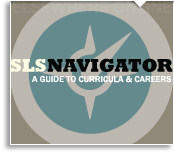Stanford Law School Makes Course and Career Guide for Law Students Available to the Public: SLSNavigator
STANFORD, Calif., August 16, 2012—Stanford Law School today unveiled to the public SLSNavigator—an online “career and curriculum guide” that enables law students to learn about different careers in law and choose their courses accordingly. Among its many innovative features, the guide incorporates more than 1500 courses from across the university, reflecting recognition of the broad range of problem-solving and other skills today’s lawyers need to understand and help their clients. Meticulously designed over a three-year period, the content of SLSNavigator is based on extensive interviews with faculty, alumni, practicing attorneys, and other legal professionals about the substantive knowledge and skills they use. The Law School is making the guide available to the public with the hope it will be useful to students at other law schools as well.
SLSNavigator was built in-house as part of a broad effort to help students decide what kind of legal career suits them and make the most out of their three years of law school. It is meant to function in connection with other forms of career guidance, which at Stanford includes the Law School’s Office of Career Services and facilitated opportunities to meet, talk to, and network with alumni. Students can useSLSNavigator to learn what different legal practices entail, to develop questions about career possibilities, and to choose among the wide range of courses identified and pre-approved by the Law School as relevant for different kinds of law.
The guide is flexible enough to work for students at any stage in their thinking. Students can choose a general kind of practice—litigation, transactional, regulatory and policy, or academic—together with a specific practice area, such civil rights/liberties, education, health law, intellectual property. Choices in this regard can be very broad (e.g., litigation/business) or very specific (e.g., transactional, health care—providers), with more than 50 career paths available. Students can then learn about the area and career options within their chosen parameters, but then also use the “map it” feature to home in on specific courses (broken out into foundational courses, key requirements, and other relevant or recommended courses). SLSNavigator includes not only all courses offered at the law school, but also relevant courses throughout the university—each containing information about the course and an explanation as to why it is relevant to a chosen practice. Students can also drill deeper for recommendations of journals to read, blogs to follow, and other resources that are most useful for the career in question.
The development of SLSNavigator was part of a set of comprehensive reforms to Stanford Law School’s legal curriculum that were initiated by Larry Kramer, Richard E. Lang Professor of Law and Dean, beginning in November 2006 to better prepare students for the changing practice of law.
“Law students need more today than the traditional second- and third-year law school curriculum offers them. It is important for 2Ls and 3Ls to learn more legal doctrine, but it is equally important for them to learn how to think like their clientsduring the upper years,” said Dean Kramer, who spearheaded the development ofSLSNavigator. “To enable students to do that, we made significant changes to the curriculum and we then created this tool to help them navigate the curriculum according to their personal career goals.”
“We encourage our students to think about their career goals much more broadly,” Kramer said. “SLSNavigator helps students do that, while also giving them good advice on how best to take advantage of Stanford’s wide-ranging curriculum options.”
The first phase of curriculum reforms were completed in February 2012 and include successfully transforming the traditional law degree into a multi-dimensional JD, which combines the study of other disciplines with team-oriented, problem-solving techniques together with expanded clinical training that enables students to represent clients and litigate cases while in law school.
“We’ve utilized the whole university to create a multi-dimensional legal education, because we think lawyers have a valuable role to play in helping to solve the world’s problems and that calls for more than knowing how to analyze case law,” said Kramer. “And we think we are uniquely positioned among law schools to produce lawyers who do that.”
To view SLSNavigator, click here: http://slsnavigator.law.stanford.edu/
About Stanford Law School
Stanford Law School is one of the nation’s leading institutions for legal scholarship and education. Its alumni are among the most influential decision makers in law, politics, business, and high technology. Faculty members argue before the Supreme Court, testify before Congress, produce outstanding legal scholarship and empirical analysis, and contribute regularly to the nation’s press as legal and policy experts. Stanford Law School has established a new model for legal education that provides rigorous interdisciplinary training, hands-on experience, global perspective and focus on public service, spearheading a movement for change.
About Stanford Law School Dean Larry Kramer
Larry Kramer joined Stanford Law School in 2004 as Richard E. Lang Professor of Law and Dean. He is also professor (by courtesy) of history and professor (by courtesy) of political economy at the Graduate School of Business. As the school’s 12th dean, he has spearheaded significant educational reforms, including dramatically expanding joint degree programs as part of a multidisciplinary approach to legal studies, enlarging the clinical education program to promote reflective lawyering, revamping programs to foster a public service ethos, and building the international law program to support a growing emphasis on globalization in legal practice.

